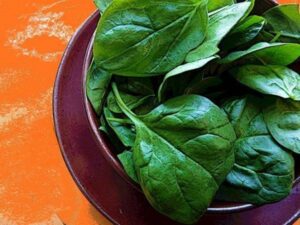Spinach

Contents:
Season for Spinach
Spinach Described
How to Buy and Store Spinach
How to Cook Spinach
Health Benefits of Spinach
Why Buy Natural and Organic Spinach
Season for Spinach: March – May, September – October
Spinach Described
A La Florentine – you taste as good as you sound! In the Sixteenth Century the Queen of France (who hailed from Florence) loved spinach so much she insisted it served at every meal – hence, the term Florentine that’s attached to dishes showcasing this special green. Spinach with its dark jade leaves, delicate texture and bitter flavor profile, has garnered itself a high ranking amongst the healthiest foods on earth. The shape of spinach leaves depends upon the variety – those being the crinkly savoy, the flat/smooth-leaf which is just that and semi-savoy which is – you got it – semi crinkly.
How to Buy and Store Spinach
The more crisp and vibrant your spinach, the healthier it will be for you. So select bunches with bright, richly-colored leaves, avoiding limp, yellowing ones or those will a pale color or any signs of slime. Spinach is also available canned or frozen; while Popeye didn’t seem to have a problem popping open a can of spinach, we strongly recommend forgoing the processed spinach in favor of its fresh counterpart. This way you can steer clear of the health hazards associated with Bisphenol A (BPA) found in the lining of most cans. Keep fresh spinach in the fridge for up to five days, and don’t wash it until you’re ready to use it. The longer spinach sits, the more nutrients it loses.
How to Cook Spinach
You’ll garner the most health benefits by enjoying your spinach raw, steamed, or quickly boiled. A one-minute boil can release a large amount of spinach’s acid content, making it sweet and tender. Wash your spinach well, as dirt has a tendency to cling to its leaves. Swish your spinach around in a bowl of water until the dirt lifts, drain the water, and then repeat. But don’t leave the spinach to soak in the water as it will lose water-soluble nutrients. Baby spinach is great as a salad base – really, a handful can be added to just about any savory dish with success.
Spinach added to soups or stews in the last minute or two of cooking adds color, flavor and nutrients. Try our super soup: Organic Broccolini & Spinach Soup
Health Benefits of Spinach
Spinach has a unique mixture of phytonutrients that gives it stellar antioxidant powers and anti-inflammatory properties. In spinach you’ll find dietary fiber that supports digestive health, a good source of muscle-building protein, and a combo of phosphorus, iron and vitamin B2 that all up your energy. It’s also a reputable source of omega-3 fatty acids and folate, potassium, vitamin B6, niacin and selenium that all promote a healthy heart. In addition, spinach helps out those bones with vitamin K, magnesium, manganese and calcium.
Why Buy Natural and Organic Spinach
The Environmental Working Group’s “Shopper’s Guide to Pesticides” places spinach among the 12 foods on which pesticide residues have been most frequently found, and we believe them! Owing to the fact that dirt clings so strongly to spinach leaves, it’s no surprise pesticides are also sticking around, one of those being DDT. Therefore, we put spinach on the “definitely yes” when it comes to buying organic.
image: Donna Cleveland

